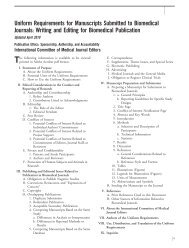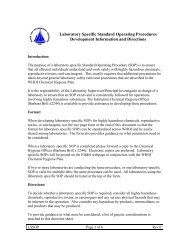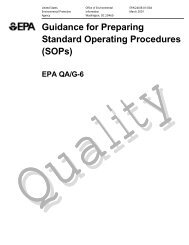Acrylamide in Baking Products: A Review Article
Acrylamide in Baking Products: A Review Article
Acrylamide in Baking Products: A Review Article
You also want an ePaper? Increase the reach of your titles
YUMPU automatically turns print PDFs into web optimized ePapers that Google loves.
542 Food Bioprocess Technol (2011) 4:530–543Henle, T., Zehetner, G., & Klostermeyer, H. (1995). Fast and sensitivedeterm<strong>in</strong>ation of furos<strong>in</strong>e. Zeitschrift fur Lebensmittel-Untersuchung und Forschung, 200, 235–237.Hidalgo, F. J., & Zamora, R. (2007). Conversion of phenylalan<strong>in</strong>e <strong>in</strong>tostyrene by 2,4-decadienal <strong>in</strong> model systems. Journal of Agricultureand Food Chemistry, 55, 4902–4906.Hoenicke, K., & Gatermann, R. (2004). Stability of acrylamide <strong>in</strong> fooddur<strong>in</strong>g storage. Czech Journal of Food Science, 22, 355–356.Hoenicke, K., & Gatermann, R. (2005). Studies on the stability ofacrylamide <strong>in</strong> food dur<strong>in</strong>g storage. Journal of AOAC International,88, 268–273.IRAC (International Agency for Research on Cancer). (1994). Some<strong>in</strong>dustrial chemicals. IRAC Monographs on the Evaluation ofCarc<strong>in</strong>ogenic Risk for Chemicals to Humans, vol. 60 (p. 435).IRAC, Lyon, France.Johnson, K. A., Gorz<strong>in</strong>ski, S. J., Bodner, K. M., Campbell, R. A.,Wolf, C. H., Friedman, M. A., et al. (1986). Chronic toxicity andoncogenicity study on acrylamide <strong>in</strong>corporated <strong>in</strong> the dr<strong>in</strong>k<strong>in</strong>gwater of Fischer 344 rats. Toxicology and Applied Pharmacology,85, 154.Jung, M. Y., Choi, D. S., & Ju, J. W. (2003). A novel technique forlimitation of acrylamide formation <strong>in</strong> fried and baked corn chipsand <strong>in</strong> French fries. Journal of Food Science, 68, 1287–1290.Kita, A., Bråthen, E., Knutsen, S. H., & Wicklund, T. (2005).Effective ways of decreas<strong>in</strong>g acrylamide content <strong>in</strong> potato crispsdur<strong>in</strong>g process<strong>in</strong>g. Journal of Agricultural and Food Chemistry,52, 7011–7016.Kolek, E., Simko, P., & Simon, P. (2006). Inhibition of acrylamideformation <strong>in</strong> asparag<strong>in</strong>e/D-glucose model system by NaCladdition. European Food Research and Technology, 224, 283–284.Kroh, L. W. (1994). Caramelisation <strong>in</strong> food and beverages. FoodChemistry, 51, 373–379.Lev<strong>in</strong>e, R. A., & Ryan, S. M. (2009). Determ<strong>in</strong><strong>in</strong>g the effect ofcalcium cations on acrylamide formation <strong>in</strong> cooked wheatproducts us<strong>in</strong>g a model system. Journal of Agricultural andFood Chemistry, 57, 6823–6829.Lev<strong>in</strong>e, R. A., & Smith, R. E. (2005). Sources of variability ofacrylamide levels <strong>in</strong> cracker model. Journal of Agricultural andFood Chemistry, 53, 4410–4416.L<strong>in</strong>dsay, R. C., & Jang, S. (2005). Chemical <strong>in</strong>tervention strategies forsubstantial suppression of acrylamide formation <strong>in</strong> fried potatoproducts. Advances <strong>in</strong> Experimental Medic<strong>in</strong>e and Biology, 561,393–404.Mestdagh, F., Maertens, J., Cucu, T., Delporte, K., Van Peteghem, C.,& De Meulenaer, B. (2008). Impact of additives to lower theformation of acrylamide <strong>in</strong> a potato model system through pHreduction and other mechanisms. Food Chemistry, 107, 26–31.Morales, F. J., Romero, C., & Jiménez-Pérez, S. (1997). Chromatographicdeterm<strong>in</strong>ation of bound hydroxymethylfurfural as an<strong>in</strong>dex of milk prote<strong>in</strong> glycosylation. Journal of Agricultural andFood Chemistry, 45, 1570–1573.Mottram, D. S., Wedzicha, B. L., & Dodson, A. T. (2002). <strong>Acrylamide</strong>is formed <strong>in</strong> the Maillard reaction. Nature, 419, 448–449.Mustafa, A., Andersson, R., Rosen, J., Kamal-Eld<strong>in</strong>, A., & Aman, P.(2005). Factors <strong>in</strong>fluenc<strong>in</strong>g acrylamide content and color <strong>in</strong> ryecrisp bread. Journal of Agricultural and Food Chemistry, 53,5985–5989.Norris, M. V. (1967). <strong>Acrylamide</strong>. In F. Dee Snell & C. L. Hilton(Eds.), Encyclopedia of <strong>in</strong>dustrial chemical analysis, vol. 4(pp. 160–168). New York: Interscience.Noti, A., Biedermann-Brem, S., Biedermann, M., Grob, K., Albisser,P., & Real<strong>in</strong>i, P. (2003). Storage of potatoes at low temperatureshould be avoided to prevent <strong>in</strong>creased acrylamide formationdur<strong>in</strong>g fry<strong>in</strong>g or roast<strong>in</strong>g. Mittelilung Lebensmittel und Hygiene,94, 167–180.Press release: HEATOX project completed—br<strong>in</strong>gs new pieces to theacrylamide puzzle. 2007. Livsmedelsverket, pp. 9–19.Ramirez-Jimenez, A. J. (1998). Indicators de las reacciones depardeamiento químico en productos panarios. Memory ofpharmacy degree of licenciate, The University of Granada,Spa<strong>in</strong>.Ramirez-Jimenez, A. J. (2001). Pardeamiento quimico en derivados decereals: productos y cereales <strong>in</strong>fantiles. PhD thesis, University ofGranada, Spa<strong>in</strong>.Ramírez-Jiménez, A., Guerra-Hernández, E., & García-Villanova, B.(2000). Brown<strong>in</strong>g <strong>in</strong>dicators <strong>in</strong> bread. Journal of Agriculture andFood Chemistry, 48, 4176–4181.Ruiz, J. C., Guerra-Hernandez, E., & García-Villanova, B. (2004).Furos<strong>in</strong>e is a useful <strong>in</strong>dicator <strong>in</strong> pre-baked breads. Journal of theScience of Food and Agriculture, 84, 366–370.Rydberg, P., Eriksson, S., Tareke, E., Karlsson, P., Ehrenberg, L., &Tornqvist, M. (2003). Investigations of factors that <strong>in</strong>fluence theacrylamide content of heated foodstuffs. Journal of Agriculturaland Food Chemistry, 51(24), 7012–7018.Sadd, P. A., Hamlet, G. H., & Liang, L. (2008). Effectiveness ofmethods for reduc<strong>in</strong>g acrylamide <strong>in</strong> bakery products. Journal ofAgricultural and Food Chemistry, 56, 6154–6161.Samuelson, G. (2003). <strong>Acrylamide</strong> <strong>in</strong> food—An update. Scand<strong>in</strong>avianJournal of Nutrition, 46, 157.Smith, E. A., & Oehme, F. W. (1991). <strong>Acrylamide</strong> and polyacrylamide:A review of production, use, environmental fate andneurotoxicity. <strong>Review</strong>s on Environmental Health, 9, 215.Stadler, R. H., Blank, I., Varga, N., Robert, F., Hau, J., Guy, P. A., etal. (2002). <strong>Acrylamide</strong> from Maillard reaction products. Nature,419, 449–450.Summa, C., Wenzl, T., Brohee, M., De La Calle, B., & Anklam, E.(2006). Investigation of the correlation of the acrylamide contentand the antioxidant activity of model cookies. Journal ofAgricultural and Food Chemistry, 54, 853–859.Surdyk, N., Rosén, J., Andersson, R., & Åman, P. (2004). Effects ofasparag<strong>in</strong>e, fructose and bak<strong>in</strong>g conditions on acrylamide content<strong>in</strong> yeast-leavened wheat bread. Journal of Agricultural and FoodChemistry, 52, 2047–2051.Svensson, K., Abramsson, L., Becker, W., Glynn, A., Hellenas, K. E.,L<strong>in</strong>d, Y., et al. (2003). Dietary <strong>in</strong>take of acrylamide <strong>in</strong> Sweden.Journal of Food Chemistry and Toxicology, 41, 1581–1586.Taeymans, D., Wood, J., Ashby, P., Blank, I., Studer, A., Stadler, R. H.,et al. (2004). A review of acrylamide: An <strong>in</strong>dustry perspective onresearch, analysis, formation, and control. Critical Revue <strong>in</strong> FoodScience and Nutrition, 44, 323–347.Tareke, E. (2003). Identification and orig<strong>in</strong> of potential backgroundcarc<strong>in</strong>ogens: Endogenous isoprene and oxiranes, dietary acrylamide.Doctoral thesis, Department of Environmental Chemistry,Stockholm University, Sweden.Tareke, E., Rydberg, P., Karlsson, P., Eriksson, S., & Törnqvist, M.(2002). Analysis of acrylamide, a carc<strong>in</strong>ogen formed <strong>in</strong> heatedfoodstuffs. Journal of Agricultural and Food Chemistry, 50,4998–5006.Tkachuk, R. (1979). Free am<strong>in</strong>o acids <strong>in</strong> germ<strong>in</strong>ated wheat. Journal ofthe Science of Food and Agriculture, 30, 53–58.Tomoda, Y., Hanaoka, A., Yasuda, T., Takayama, T., Hiwatashi, A.(2004). US Patent Application 20040126469.Törqvist, M. (2005). <strong>Acrylamide</strong> <strong>in</strong> food: The discovery and itsimplications. In M. Friedman & D. Mottram (Eds.), Chemistryand safety of acrylamide <strong>in</strong> food (pp. 1–19). New York: Spr<strong>in</strong>gerScience +Bus<strong>in</strong>ess Media Inc.Umano, K., & Shibamoto, T. (1987). Analysis of acrole<strong>in</strong> from heatedcook<strong>in</strong>g oils and beef fat. Journal of Agriculture and FoodChemistry, 35, 909–912.Vadlamani, K. R., & Seib, P. A. (1999). Effect of z<strong>in</strong>c and alum<strong>in</strong>umions <strong>in</strong> breadmak<strong>in</strong>g. Cereal Chemistry, 76, 355–360.







